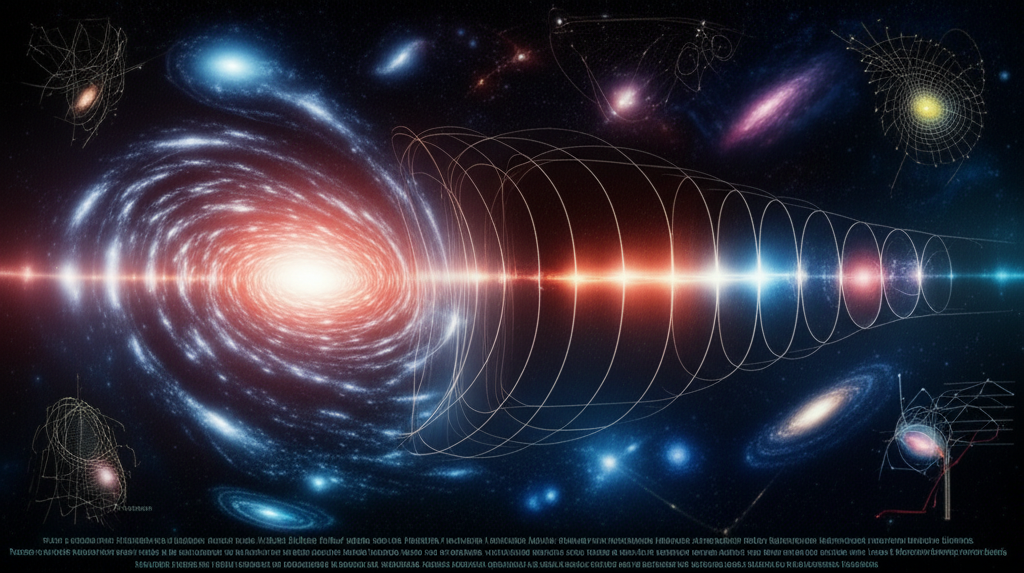Cyclic Universe vs Multiverse: Comparing Two Theories on Cosmic Origins
Explore the differences between the Cyclic Universe and Multiverse theories. Learn how each model explains the cosmos, its origins, and its potential future.

Introduction
Cosmology explores the universe’s origin, structure, and ultimate fate. The Big Bang theory, a cornerstone of modern cosmology, suggests the universe began from a singular point. However, this theory faces limitations, such as explaining the universe’s initial conditions and its eventual end.
Alternative models offer fresh perspectives. The Cyclic Universe theory proposes an endless series of expansions and contractions. Meanwhile, the Multiverse theory suggests our universe is one of many. These models challenge traditional views and expand our understanding of cosmic possibilities.
Understanding the Cyclic Universe Model
Basic Principles
The cyclic universe model suggests the cosmos undergoes endless cycles of expansion and contraction. Each cycle ends with a ‘bounce’, leading to a new universe. Dark energy plays a key role by driving the expansion phase apart. The Ekpyrotic scenario, a variant, proposes that our universe resulted from a collision between higher-dimensional membranes.
Solving Big Bang Problems
This model offers solutions to several Big Bang theory issues. It addresses the horizon problem by suggesting a pre-Big Bang phase that homogenized the universe. For the flatness problem, it provides alternatives to cosmic inflation. Additionally, it naturally avoids the monopole problem by not requiring high-energy phase transitions.
Observational Evidence and Predictions
Scientists look for gravitational waves as evidence of cyclic events. They also study the cosmic microwave background (CMB) for non-Gaussian patterns. Primordial black holes might hold clues, as their existence could support the cyclic model’s predictions.
The Multiverse Theory Explored
Defining the Multiverse
The multiverse theory suggests our universe might be one of many. Scientists propose different types of multiverses. These include bubble universes and parallel universes. Quantum mechanics and string theory play key roles in this idea. They help explain how multiple universes could exist.
Evidence and Theoretical Support
Cosmic inflation supports the bubble universe concept. It suggests rapid expansion created separate universe bubbles. The many-worlds interpretation of quantum mechanics hints at parallel universes. Every quantum decision might spawn a new universe. These theories offer a glimpse into the vast possibilities beyond our own universe.
Comparative Analysis
Cyclic Universe vs. Multiverse
The Cyclic Universe theory suggests the universe undergoes endless cycles of expansion and contraction. Conversely, the Multiverse theory posits the existence of multiple, perhaps infinite, universes with varying physical constants.
Key differences and similarities include:
- Both theories challenge the notion of a singular, linear universe timeline.
- The Cyclic Universe focuses on temporal cycles, while the Multiverse emphasizes spatial or dimensional multiplicity.
Theoretical strengths and weaknesses:
- The Cyclic Universe offers a solution to the Big Bang’s initial conditions problem but struggles with entropy accumulation over cycles.
- The Multiverse provides a framework for understanding fundamental constants’ values but lacks direct observational evidence.
Addressing Common Misconceptions
Clarifying the nature of cycles in the universe:
Cycles in the Cyclic Universe theory do not imply exact repetition. Each cycle may introduce variations in physical laws or constants.
Understanding the scope of multiverse theories:
Multiverse theories vary widely. Some propose parallel universes with slight differences, while others imagine entirely separate dimensions with different physical laws.
Challenges and Open Questions
For the Cyclic Model
The cyclic model faces several challenges. First, the singularity issue at bounce points raises questions about the universe’s behavior during these transitions. Next, entropy accumulation over cycles suggests a potential limit to the number of cycles. Lastly, ensuring consistency with current observations remains a hurdle for theorists.
For the Multiverse Theory
The multiverse theory also encounters significant obstacles. A major issue is the lack of direct observational evidence, making it difficult to test. Additionally, the theory brings up deep theoretical and philosophical implications about the nature of reality.
Future Directions in Cosmology
Emerging technologies and methodologies are reshaping cosmology. Advanced telescopes and quantum computing offer new ways to observe the universe. These tools may unlock mysteries of cosmic origins.
Potential breakthroughs in understanding cosmic origins are on the horizon. Scientists explore the cyclic universe and multiverse theories with fresh data. This could redefine our grasp of existence.
Moreover, interdisciplinary approaches merge physics with other sciences. Such collaborations might reveal unexpected insights into the universe’s fabric. The future of cosmology looks promising and boundless.
Conclusion
The Cyclic Universe and Multiverse theories offer fascinating perspectives on the cosmos. The Cyclic Universe suggests a never-ending cycle of big bangs and crunches. Meanwhile, the Multiverse theory proposes the existence of multiple, perhaps infinite, universes. Both theories challenge our understanding of reality.
Continued research and exploration are vital. They not only deepen our knowledge but also push the boundaries of physics. Future discoveries could support one theory over the other or introduce entirely new concepts. The quest for understanding the universe’s true nature remains one of science’s most exciting endeavors.
Citations
- The Cyclic Universe: A Brief Review by Paul Steinhardt explores the concept of a universe that undergoes endless cycles of expansion and contraction.
- Understanding the Multiverse provides insights into the theory that suggests the existence of multiple, perhaps infinite, universes.
- Gravitational Waves and Cosmology discusses how gravitational waves offer clues about the universe’s structure and evolution.
- Dark Energy’s Role in the Universe examines the mysterious force accelerating the universe’s expansion.







